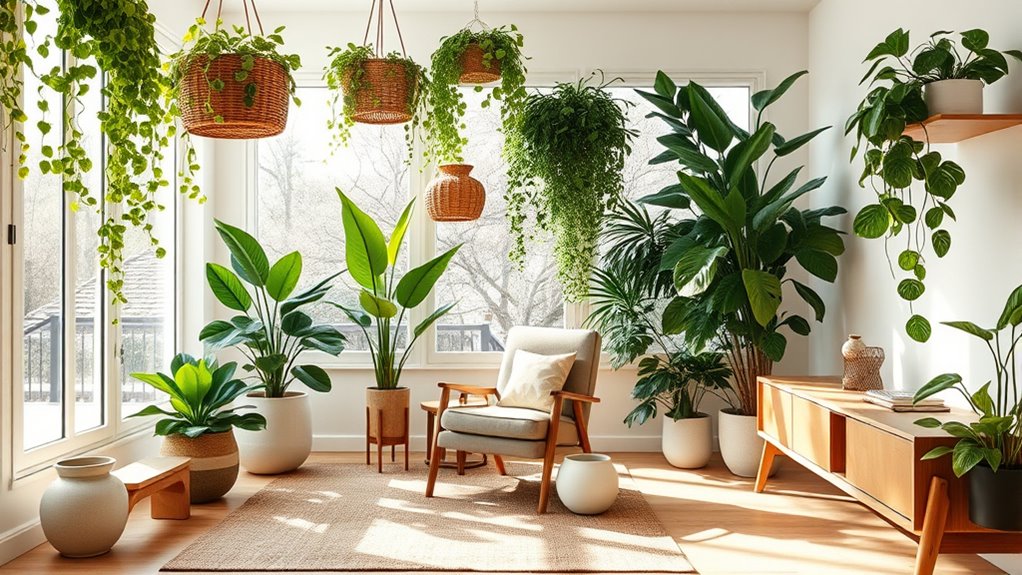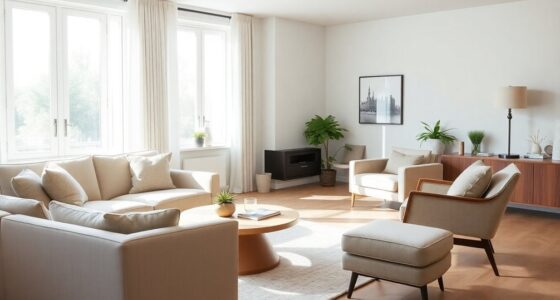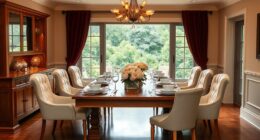To integrate indoor plants and natural elements into your living space, choose plants suited to your environment and care for them properly. Incorporate natural decor like wooden planters, stone accents, and woven textiles to create a balanced, organic feel. Position plants thoughtfully—near windows or seating areas—and group them for a lush look. Adding natural fibers and accessories enhances the vibe. Keep up with simple maintenance to nurture your sanctuary. Discover more ways to transform your space into a calming, vibrant haven.
Key Takeaways
- Select plants suited to your light, humidity, and care preferences for easier maintenance and healthier growth.
- Use natural decor materials like wood, stone, and bamboo to create a cohesive, organic aesthetic.
- Position taller plants near seating areas and smaller plants on shelves to enhance visual interest and tranquility.
- Group plants together to evoke a lush, jungle-like atmosphere that promotes relaxation.
- Incorporate natural fibers and accessories for texture, and regularly maintain plants to foster a vibrant, calming environment.

Bringing indoor plants and natural elements into your living space can transform it into a calming, vibrant sanctuary. When you focus on plant care, you not only guarantee your greenery thrives but also create a thriving environment that enhances your home’s natural decor. The key is to choose plants that suit your lifestyle and environment, then learn how to care for them properly. This means paying attention to watering schedules, light requirements, and humidity levels. For example, succulents and cacti need infrequent watering and plenty of sunlight, while ferns prefer more moisture and indirect light. By understanding the specific needs of your plants, you make it easier to keep them healthy and vibrant, which in turn adds a lively touch to your home.
Create a vibrant, calming home by selecting and caring for indoor plants suited to your environment.
Incorporating natural decor elements involves more than just plants. Think about materials like wood, stone, bamboo, and woven textiles that complement your greenery. You can add wooden planters, stone sculptures, or bamboo shelves to create a cohesive look that emphasizes nature’s beauty. These elements serve as both functional pieces and visual accents, enriching your space and making it more inviting. When you combine natural decor with plants, you craft an environment that feels organic and balanced. This approach helps you connect with nature even indoors, promoting relaxation and well-being.
Additionally, considering the placement and arrangement of your indoor plants can maximize their calming effect and aesthetic appeal. Place taller plants where they can be appreciated, such as near seating areas or windows, and smaller plants on shelves or tables. Grouping plants in clusters can also create a lush, jungle-like atmosphere that’s both aesthetically pleasing and soothing. Don’t forget to consider the lighting – some plants thrive in bright, direct sunlight, while others prefer shaded spots. Adjust your placement accordingly, and you’ll find that your indoor environment feels more alive and harmonious.
Another way to integrate natural decor is through accessories that evoke the outdoors. Incorporate natural fiber rugs, wicker baskets, or linen curtains to complement your greenery. These textures add depth and warmth, making your living space more inviting. Regular maintenance, like dusting leaves or trimming dead foliage, not only keeps your plants looking their best but also reinforces your role as a caring gardener. As you become more confident in plant care, you’ll notice your space transforming into a sanctuary filled with vitality and tranquility. This seamless blend of indoor plants and natural decor creates an environment that nurtures your mind and body, making every day feel a little more serene.
Incorporating elements inspired by Water Parks can also add a refreshing vibe to your space, such as incorporating water features or aquatic-themed decor, which can evoke a sense of leisure and relaxation.
Frequently Asked Questions
How Do I Choose the Right Indoor Plants for Low-Light Areas?
To select the right indoor plants for low-light areas, look for options with low light requirements like snake plants, pothos, or ZZ plants. Consider plant care tips such as avoiding overwatering and keeping leaves dust-free to help them thrive. You should also test the light levels in your space to confirm they match the plant’s needs. This way, you’ll choose resilient plants that flourish even in dimmer spots.
What Are the Best Natural Materials for Eco-Friendly Furniture?
You should choose natural materials like bamboo, reclaimed wood, cork, and organic cotton for eco-friendly furniture. These materials often come from sustainable sourcing, reducing environmental impact. Look for pieces with biodegradable finishes to guarantee they decompose safely at end-of-life. By selecting furniture made from these materials, you support sustainability and help create a healthier living space that aligns with eco-conscious values.
How Can I Prevent Pests on Indoor Plants?
Think of your indoor plants as delicate treasures needing a watchful guardian. To prevent pests, regularly inspect your plants for signs of trouble, like discolored leaves or webbing. Use pest prevention methods such as neem oil or insecticidal soap, and keep your plants healthy with proper watering and light. Staying vigilant and consistent in plant inspection helps you catch problems early, ensuring your greenery flourishes pest-free and vibrant.
What Maintenance Is Required for Natural Water Features Indoors?
You need to regularly check your indoor water feature’s water quality, making certain it stays clean and free of algae or debris. Change the water every few weeks and use a water conditioner if needed. Additionally, perform pump maintenance by cleaning and inspecting it monthly to prevent clogs and ensure smooth operation. This simple upkeep keeps your water feature looking beautiful and functioning properly, enhancing your space’s natural vibe.
Are There Safety Concerns With Certain Indoor Plants Around Pets?
Yes, certain indoor plants pose pet toxicity risks, so you should be cautious with plant placement. Some plants, like lilies or pothos, can be harmful if pets chew on them. To keep your pets safe, research each plant’s toxicity level and place potentially dangerous plants out of their reach. This way, you enjoy the benefits of greenery without risking your pet’s health.
Conclusion
Bringing indoor plants and natural elements into your home transforms it into a lush oasis, much like a garden blooming within your walls. These touches breathe life, color, and tranquility into your space, making everyday moments feel like a walk through nature’s sanctuary. Embrace this natural harmony, and watch your living space flourish into a sanctuary that nurtures your soul. After all, your home is the canvas, and nature’s touch is the vibrant paint that awakens it.








